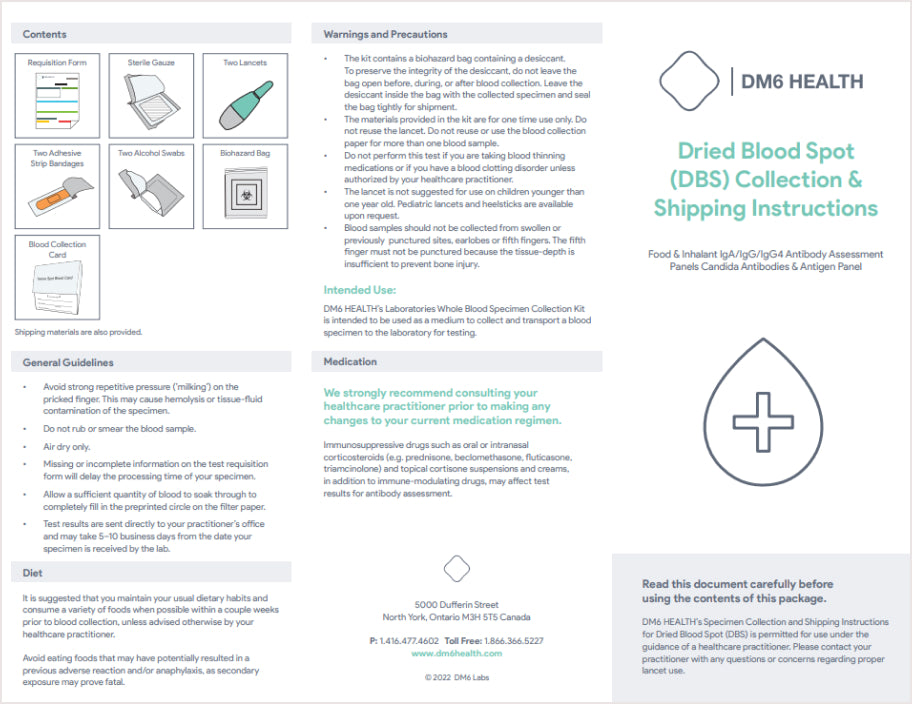
Our labs are :
.png?v=134991182274568218411663756760)
Same Labs as
Physicians & Hospitals

Confidential Results
Within 10 Days

Free
Shipping

Discreet
Packaging

All payments
Accepted
TEST DETAILS

This bundle package measures your immune system's IgG antibody reactivity to 96 foods and measures your Vitamin D (total, 25-hydroxy D2 and D3) in the blood.
Checking your vitamin D level can help you understand if you're maintaining an adequate level of this important vitamin.
A higher than normal IgG reactivity level can mean that there’s a possibility that specific foods can be making you uneasy and unwell—making that food an ideal candidate to include in your list to initially remove in a two-part elimination diet.
This test may be right for you if you: Have experienced mild symptoms but haven’t been diagnosed with a food allergy, which may include:
- Tingling or itching of your face, lips, mouth, tongue, or throat
- Itchy or watery eyes
- Hives or skin rash, or itchy skin
- Runny nose, sneezing, congestion
- Weakness, Joint Pain, Muscle Pain, Chronic fatigue or feeling tired
Is this Test Right for Me
Testing alone cannot be used to diagnose a medical condition. Your healthcare provider will use your test results, in combination with your symptoms, medical history, family history, and physical exam, to determine the appropriate next steps for evaluation and treatment.
Each food will be rated on a Class scale of 0-5
Each food will be rated on a Class scale of 0-5: Class 0 (normal reactivity) to Class 5 (high reactivity). A higher than normal IgG reactivity level can mean that there’s a possibility that food can be giving you symptoms—making that food an ideal candidate to include in your list to initially remove in a two-part elimination diet. This test is not a food allergy test, nor can it determine lactose intolerance or celiac disease.
Dairy
Fish/Shellfish
Fruits
Misc/Herbs/Spices
Vegetables
Grains/Legumes/Nuts
Meat/Poultry
Egg
Candida Albicans
Vitamin D (Total) 25-Hydroxy D2 D3
Your test results will show your vitamin D level rated on a Class scale of 4 categories:
You should take this test if you suffer from:

What’s included in the package:
Lancets
Return Label
and EnvelopeBandage
Biohazard Bag
Alcohol pad
Blood spot card
View the tutorial video on how to collect your sample(s).
- Dried Blood Spot Collection
How DM6 works
Blood Sample
Saliva Sample
Purchase
your DM6 test kit

Standby as you test kit will be shipped within 24 hours of your purchase
Collect
your sample

Please follow the instruction manual provided. Your quick at-home collection is all we need to do a thorough lab analysis.
Mail
your sample

Simply place your sample in the packaging provided and send it to our approved lab — the shipping costs are on us
Review
your results

Get first hand access to your invaluable health data. View your results and recommendations online. Knowledge is power!
With Every Test Kit You Will Also Receive


Physician reviewed results


Pre-Paid Shipping both ways


All material for sample collection and shipping back to the lab


Detailed direction and an instructional video to guide you


Help along the way from our customer care team


Digital and printable results you may share with family and/or your health provider
Vitamin D is not actually a vitamin. In fact, it is a steroid hormone that is produced from cholesterol when your skin gets exposed to the sun. Vitamin D is a fat soluble vitamin, meaning that it dissolves in fats and oils and can be stored in your body for a long time.
Food allergies are recognized to trigger adverse reactions such as skin conditions, GI problems, anaphylaxis, and more. With proper identification and elimination of the offending foods many experiences symptom relief and reaction evasion. Our IgE antibody panels serve as a useful tool in the identification of triggering foods in individuals.
Symptoms and conditions associated with Vitamin D and food sensitivities are:
Trusted By 10,000
Customers Around
The World

Customer Reviews
Frequently Asked Questions
How long will it take for me to receive my results?
Results are typically sent within 7-10 business days from the time we receive your sample.
Who can order a DM6 Health test?
This test is only for adults aged 18 and older. The test can only be ordered within Canada.
Does my insurance cover DM6 tests?
Some insurance may cover DM6 Health Test. Please check with your provider first. A receipt will be provided to submit to your insurance. Typically patients with HCSA will cover it.
How long will it take for my order to arrive?
Orders are processed for shipping within 24 hours from the time they are received. Please allow 4-5 business days for your order to arrive.
Do You Offer Refunds?
If a test was purchased on dm6health.com and your order hasn’t shipped, we can offer a full refund upon request. If your order has already shipped, we can offer a full refund minus $30.00 to cover shipping and handling fees. In addition, if you notify us that a submitted test was used by a minor before our lab begins processing, we can offer a refund minus $30.00. If we discover that an account was created and contains results from a minor, we will remove the account within 24 hours and no refund will be issued. For any other questions regarding this policy, please feel free to contact our Customer Care Team at info@dm6health.com
What is vitamin D?
Bone health is extremely important, vitamin D is an essential vitamin that helps regulate calcium in our bodies. Vitamin D supports healthy bone density, insulin production, and immune function. Vitamin D can be found in certain foods such as fish, eggs and fortified milk however the recommended amount may not be sufficient enough therefore it can also be acquired through our skin when exposed to sunlight and or supplementation.
What are the risks of vitamin D deficiency?
Vitamin D deficiency can lead to increased susceptibility to infection. Deficiency usually affects older people who aren’t exposed to enough sunlight or don’t eat vitamin-enriched foods and increases their risk of fractures. Typical symptoms include Body Weakness, Joint pain, Muscle pain, Fatigue or feeling tired, as well as thinning hair.
What is a Food Sensitivity test?
A Food sensitivity test is a test that measures your IgG antibody to help determine possible foods that may be causing certain intolerable symptoms. An Immunoglobulin test assesses the level of antibodies in our blood. Our immune system creates antibodies to help protect the body from different viruses and allergens. Our body makes different immunoglobulins to help fight different things. IgG is the most common antibody in the blood that helps protect us from viral infections. An IgG reaction to food proteins indicates tolerance related to immune cell reaction. Continued exposure, inflammation, and immune reactivity is the contributing factor to sensitivity and high IgG in response to food proteins. It is important to understand how our immune system responds to different types of food. An elimination diet could be a way to help you figure out which foods that may be causing certain symptoms you could be experiencing.
What is the difference between a Food Sensitivity test VS and Allergy Test?
Since you could potentially be experiencing similar symptoms to perhaps a food allergy it is important to know the difference between a food allergy test VS a food sensitivity test. The key difference between an allergy and a sensitivity is your body's response. When you are experiencing an allergy to certain foods your immune system is causing this reaction. However, when experiencing a sensitivity or an intolerance this is a reaction caused by your digestive system. The most obvious difference is a food sensitivity will never cause an anaphylactic response whereas a food allergy typically will, this can be serious and potentially life threatening. Food allergies are investigated by IgE antibodies, and symptoms for food allergies typically occur within minutes to hours of exposure. Food sensitivities involve the IgG antibody, and symptoms usually occur much slower and are not potentially life-threatening. Food sensitivities will trigger a reaction within our digestive system or gastrointestinal tract which will create many of the symptoms you may be currently feeling. Food Sensitivities are way more common but more complex than food allergies, one being harder to detect. Please note, this Food Sensitivity test does not test for lactose intolerance, IBS, or celiac disease.
Who should take the Food Sensitivity Test?
Our immune system responds in different ways to different foods so if you’re experiencing symptoms such as bloating, stomach pain, headaches, or skin irritation, and aren’t sure what is causing them, it is possible that your immune response to some foods you are eating are causing these issues.
Our Food Sensitivity Test can detect your body’s IgG immune response to 96 or 208 common foods.
Your body may have an immune response to foods you eat, which may worsen or trigger a wide range of symptoms . If you are looking to reintroduce potentially ‘problematic’ food back into your diet to see if you’re still reactive to it on your test results, it’s recommended to consume that food for about 4-6 weeks prior to testing.
A food sensitivity blood test measures your IgG reactivity levels for different kinds of food, using a small sample of blood. High IgG reactivity for a certain food indicates there’s a possibility that food may be involved with causing your symptoms.
Knowing your IgG reactivity levels for various foods can help you create a list of “questionable foods” to initially remove in an elimination diet – making it an easier, quicker process to get to the root cause of your symptoms of food sensitivity.
Who should not take this Food Sensitivity Test?
The results of your DM6 Food Sensitivity Test are to simply be used as a guide to temporarily eliminate the foods that could be causing your symptoms, and re-introducing them in 4-6 weeks. This is a very important step in determining which foods may be causing your symptoms.
We do not recommend taking our Food Sensitivity Test if you currently have, or are in recovery for an eating disorder (i.e., anorexia nervosa, bulimia nervosa, and binge eating disorder), or if you are hoping to achieve weight loss. The results are not intended to reduce the amount of calories you consume daily, and reduce your ability to get the essential nutrients and calories you obtain from food.
Due to the specific nutritional needs of pregnant and breastfeeding women, elimination diets are not recommended. It’s best to speak with your healthcare provider for advice should you be experiencing unwanted symptoms.
Is there such a thing as too much vitamin D?
Yes there is. In extreme cases too much vitamin D can cause Vitamin D toxicity. This can have serious health effects, such as kidney stones and bone issues.
When should I test my vitamin D levels?
Testing is recommended for people at risk of vitamin D deficiency, including those with malabsorption conditions, kidney failure, or unusual bone pain or fractures. If you live in places that have extended periods of limited sunlight, you might want to get your vitamin D levels tested.
What is a normal vitamin D level?
The normal range of vitamin D in the blood, as recognized by the DM6 medical advisory board, is 25–80 ng/mL.
How can I improve my vitamin D levels?
Finding out if you have vitamin D deficiency will allow you to adjust your lifestyle and nutrition. You can increase your vitamin D level by taking supplements or by consuming more vitamin D-enriched foods..
What will my results tell me?
Your food sensitivity results will tell you how reactive your IgG antibodies are to 96 or 208 common foods.
Each food will be rated on a Class scale of 0-5: Class 0 (normal reactivity) to Class 5 (high reactivity).
You will also get:
- Tailored suggestions about what to do next
- Help prioritizing your temporary elimination diet
- Personalized information and education
What are symptoms of food sensitivity?
If you have a sensitivity to a particular food, you might experience one or more negative reactions several hours or days after eating that food. Some reported symptoms from our customers include:
- Headaches
- Skin irritation
- Bloating
- Stomach or abdominal pain
- Indigestion
- Diarrhea
- Gastrointestinal distress
How It Works: Food Sensitivity Testing with an Elimination Diet
An elimination diet can be a useful tool for uncovering the specific foods you’re sensitive to. Basically, in an elimination diet, you temporarily remove foods from your diet that you suspect could be the cause for your symptoms. In other words, you stop eating those “questionable foods” for a given amount of time – often between 4-6 weeks.
Next, you would then add those foods back to your diet – one food at a time. Each time you add a “questionable food” back to your diet, you watch for symptoms for about 2-3 days. If a food you’re adding back doesn’t result in symptoms, then you continue eating it as a normal part of your diet. But if a food does cause you symptoms when you add it back to your diet, then you’ve likely found a food you’re sensitive to.
That’s why food sensitivity testing can make a real difference if you want to determine the foods you’re sensitive to. A food sensitivity test checks the reactivity levels of your IgG antibodies for many different foods. (IgG antibodies are another type of antibody that your immune system produces.)
If you have a high IgG reactivity level to a certain food, there’s a possibility that food may be involved with causing your food sensitivity symptoms.
So taking a food sensitivity test can give you a list of “questionable foods” that’s based on your body’s immune system response. You can then use this information to guide your elimination diet – and to choose what foods to eliminate at first. This helps remove a lot of the “guessing” in the elimination diet process – and can make it easier for you to pinpoint the foods behind your symptoms.
What is involved in a food sensitivity blood test? How is the test conducted?
An IgG food sensitivity test uses a small sample of blood to check how your IgG antibodies react to different kinds of food. You will be provided all the instructions in your DM6 Health Food Sensitivity Kit, please read them carefully before conducting your test.
Step 1: Select your ring or index fingertip and clean the desired area using the alcohol prep pad. The best site for a finger puncture is just off the center of the finger pad.
Step 2: Fold collection card open on a flat surface. Remove and discard the plastic safety end on the lancet by twisting and pulling it carefully.
Step 3: Keep in mind the lancet will only activate and puncture one time.. Place your finger against a firm surface. To activate the lancet, press down until you hear a clicking sound.
Step 4: Squeeze your finger where you punctured, moving from the base of your finger toward the fingertip to draw blood towards the puncture site. Allow a single, large blood drop to fall in each circle of the collection blood card. Ensure all circles on the collection card are filled. Make sure you complete the entire collection process on the same day. Leave the card out for 20-30 minutes or until it is completely dry. Apply a bandaid to your finger when finished if needed. Make sure to write your name and the collection date on the card.
- Choosing a selection results in a full page refresh.
- Press the space key then arrow keys to make a selection.









